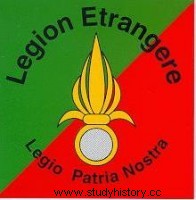
French army corps. Following the conquest of Algeria, a number of foreigners residing in France expressed the wish to serve in the French army. King Louis-Philippe ratified this wish by the ordinance of March 10, 1831 creating the Foreign Legion, which in a way took over from the Swiss Guard of the Ancien Régime. This unit has a structure identical to that of the line infantry, being divided into battalions, the number of which varies according to the numbers. In 1835, elements of this unit were placed at the service of the King of Spain, in the fight against the Carlist movement. The other units took part in all major operations in Algeria, then in the campaigns of the Second Empire, in the Crimea and in Italy. During the Mexican campaign, a detachment of the Legion distinguished itself at Camerone on April 30, 1863.
In 1867, the Legion was made up of one regiment and bore the name of foreign regiment. Under the Third Republic, the number of battalions was increased to four in 1884 and to five in 1891, the Legion having in the meantime resumed its original name. In principle, no Frenchman is allowed to join this unit, except on an exceptional basis when recruiting management staff. However, soldiers released from active service and who do not wish to re-enlist may join the
Foreign Legion on the condition that they are not in a situation which has led to their exclusion from the service. 'army. For foreigners, the duration of the commitment is five years and the age limit varies between 18 and 40 years.
The history of the Legion is one of great feats of arms of the French army, the detachments of legionnaires being always engaged as shock troops. Thus, the Legion flag bears the mention of the campaigns of Indochina and Morocco. The Legion deplores 4,000 deaths from 1914 to 1918 and double from 1939 to 1945. It is certainly one of the most popular units in the army with its green and red pennant and the white kepi of its men. The interwar period exalted the virtues of these brave fighters through song and films set in the Saharan desert. A legend attaches to these men with an often troubled, mysterious past, who came to forget or atone for faults. The spirit of adventure attracts others. In 1940, the Legion served in Narvik* and many of these men transferred to Free France in June. We find the Legion in 1941 in Eritrea, then the following year in Bir Hakeim, in the Libyan desert. Made up of 13 demi-brigades, the Legion participated in the liberation of the metropolis within the 1st army of General de Lattre de Tassigny, from Provence to Alsace. Subsequently, the Legion will play a very important role during the war in Indochina and then in Algeria, where foreign parachute regiments are created. It is partly among these units that the putschist generals will recruit their shock elements during the coup attempts, in Algiers*, in particular in May 1958, then in April 1961. After these events, the Legion will bring back its base from Sidi-bel-Abbès in Aubagne in the Bouches-du-Rhône. Part of the workforce will be stationed in Corsica, with other detachments serving in overseas bases, particularly in the Pacific. The supervision of the legionnaires is provided by French officers; but foreign officers may serve with the equivalence of their original rank.
